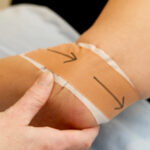Common Conditions Include:
Tennis Elbow, Golfers Elbow, Olecranon Bursitis/ Students Elbow, Triceps Tendon Strain, Entrapment of the radial nerve, cubital tunnel syndrome/ ulnar nerve entrapment, median nerve entrapment/pronator teres syndrome.
Tennis Elbow Lateral Epicondylitis/ Lateral Epicondylalgia
Tennis elbow is very common among tennis players, although it affects people who do not play tennis at all. It is usually caused by overloading the muscles at the forearm by bending the wrist backwards. In tennis players it may be due to poor technique or using the wrong racquet. This condition can also be caused by any repetitive movement such as typing, gardening, sports or any other activity that involves repetitive wrist use.
Tennis elbow affects the outer side of the elbow. It can come on suddenly (after an injury) but in most cases the onset is gradual and in the dominant arm. It usually results from a problem with the tendons that attach to the common extensor origin (where many muscles of the forearm attach), and is often caused by overuse or repetitive strain caused by repeated wrist extension (bending the wrist back). There is usually a tender area just below the bony part of the outer elbow and movements such as gripping, lifting and carrying can be painful. There can also be a minor swelling.
Left untreated, this problem can become persistent so early management is important. What is also important is that treatment of tennis elbow is very individual. We know from clinical experience that what works for one person may not necessarily work for another. That s why at Wicklow Physiotherapy Clinic we have many strategies for treating this complex condition that causes alot of pain.
The problem with tennis elbow is that living with it in the acutely sore phase is not easy. Even lifting the kettle can become excruciating. A quick fix is what everyone wants. We know from the research on tennis elbow done to date and in particular the more recent research that a quick fix is unlikely to be the answer. There is always the temptation to opt for steroid injection in the hope that this will provide some relief. And, teh majority of patients do have relief but be warned it is most often short lived.
That is why at Wicklow Physiotherapy Clinic we endeavour to use treatment strategies and exercise programmes that provide a long lasting effect. A treatment commonly used is one known as Mobilisation With Movement (MWM), which involves asking the patient to move the elbow to produce the pain and then the therapist applies a movement to take the pain. Repetitive series of these MWMs can work to alleviate patients symptoms if coupled with a progressive resisted exercise programme. Again this is not a quick and may take eight to twelve weeks to get there. The good news is though this is a programme of exercise done at home and supervised at intervals by your physiotherapist.
I also have a sore neck will I recover?
Yes if you have the correct physiotherapy. We know from the research that tennis elbow patients who present with concurrent neck or shoulder pain have a worse prognosis one year later if they do nothing. Therefore the message is if you also have a pain in your neck it is definitely time to do something about it.
It is possible that those patients with neck and arm symptoms have a more complex condition going on that affects the pain processing mechanisms at a spinal level. At Wicklow Physiotherapy Clinic we have in depth knowledge of the spinal pain system and will be able to identify which treatment is best suited to you and which treatment will provide the quickest but more importantly the longest lasting relief.
Eccentric Exercises and the Flexbar
There is some evidence that eccentric exercises of the elbow are effective in treating lateral epicondylalgia.
What is eccentric exercise?
Eccentric exercise is where the muscle and tendons in question acts as brakes, slowing or resisting a movement. Eccentric contractions require the muscle to work against a force, in this case the coiled bar.
Doing Eccentric Exercises for tennis elbow was previously difficult as there was no easy way to provide the force to resist. This has now changed with a single, inexpensive piece of exercise equipment. Called a ‘flexbar’ (see right). The Thera-Band ® FlexBar ® is a flexible, durable resistance device with a ridged surface for enhanced grip during use. And the good news is that this rubber bar is readily available and inexpensive.
We know from the literature that there are changes in the structure of the tendon when a person is suffering from tennis elbow. The theory of the flexbar exercises is that the tendon is being remodelled and thus will become strong again to withstand the loads required.
The exercise is not difficult but it is unique and a little tricky to master. That is why it is best taught by a physiotherapist with skills in the area of muscular rehabilitation. If you would like further information regarding the flexbar exercises and if you would like to make an appointment to have a comprehensive elbow assessment contact us today at Wicklow Physiotherapy Clinic.
How do I prevent a recurrence?
You need to avoid the activity that is aggravating the pain.
Your Physiotherapist will give you the correct strengthening exercises to help prevent a recurrence and identify any pre-disposing factors you may have to developing such a problem.
It is essential to have a good ergonomic set up at work and regular stretching breaks.
Your physiotherapist can help identify problems in your tennis technique that may be contributing for example: a poor backhand technique, a racket grip that is too small, strings that are too tight.







